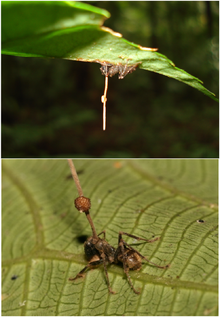| Ophiocordyceps | |
|---|---|

| |
| Dead ants infected with Ophiocordyceps unilateralis | |
| Scientific classification | |
| Domain: | Eukaryota |
| Kingdom: | Fungi |
| Division: | Ascomycota |
| Class: | Sordariomycetes |
| Order: | Hypocreales |
| Family: | Ophiocordycipitaceae |
| Genus: | Ophiocordyceps Petch (1931) |
| Type species | |
| Ophiocordyceps blattae (Petch) Petch (1931)
| |
| Synonyms[1] | |
|
Cordycepioideus Stifler (1941) | |
Ophiocordyceps is a genus of fungi within the family Ophiocordycipitaceae.[2] The widespread genus, first described scientifically by British mycologist Tom Petch in 1931,[3] contains about 140 species that grow on insects.[4] Anamorphic genera that correspond with Ophiocordyceps species are Hirsutella, Hymenostilbe, Isaria, Paraisaria, and Syngliocladium.[5]
One species complex, Ophiocordyceps unilateralis, is known for its parasitism on ants, in which it alters the behavior of the ants in such a way as to propagate itself more effectively, killing the ant and then growing its fruiting bodies from the ant's head and releasing its spores.[6][7][8] To accomplish this, infected ants are stripped of their instinctive fear of heights, and leaving the relative safety of their nests, climb up the nearest plant—a syndrome known as "summit disease".[9] The ant clamps it jaws around the plant in a "death grip" and following, mycelia grow from the ant's feet and stitch them to the surface of the plant.[9] The spores released from the ant carcass fall to the ground and infect other ants that come in contact with the spores so that this cycle continues.[10] Areas with high densities of ants that have this fungus growing out of them are known as graveyards.[11]
A 48-million-year-old fossil of an ant in the death-grip of Ophiocordyceps unilateralis was discovered in Germany.[12]
- ^ Cite error: The named reference
urlMycoBank: Ophiocordycepswas invoked but never defined (see the help page). - ^ Lumbsch TH, Huhndorf SM (December 2007). "Outline of Ascomycota – 2007". Myconet. 13. Chicago, USA: The Field Museum, Department of Botany: 1–58.
- ^ Cite error: The named reference
Petch1931was invoked but never defined (see the help page). - ^ Cite error: The named reference
Kirk2008was invoked but never defined (see the help page). - ^ Cite error: The named reference
Sung2007was invoked but never defined (see the help page). - ^ Bhanoo SN (24 August 2010). "In Fossilized Leaf, Clues to a Zombie Ant". The New York Times.
- ^ Zimmer C (24 October 2019). "After This Fungus Turns Ants Into Zombies, Their Bodies Explode". The New York Times.
- ^ Evans HC, Elliot SL, Hughes DP (March 2011). "Hidden diversity behind the zombie-ant fungus Ophiocordyceps unilateralis: four new species described from carpenter ants in Minas Gerais, Brazil". PLOS ONE. 6 (3): e17024. Bibcode:2011PLoSO...617024E. doi:10.1371/journal.pone.0017024. PMC 3047535. PMID 21399679.
- ^ a b Sheldrake, Merlin (2021). Entangled Life. New York: Random House. p. 96. ISBN 978-0-525-51032-1.
- ^ Pontoppidan, Maj-Britt; Himaman, Winanda; Hywel-Jones, Nigel L.; Boomsma, Jacobus J.; Hughes, David P. (2009-03-12). "Graveyards on the Move: The Spatio-Temporal Distribution of Dead Ophiocordyceps-Infected Ants". PLOS ONE. 4 (3): e4835. Bibcode:2009PLoSO...4.4835P. doi:10.1371/journal.pone.0004835. ISSN 1932-6203. PMC 2652714. PMID 19279680.
- ^ Pontoppidan, Maj-Britt; Himaman, Winanda; Hywel-Jones, Nigel L.; Boomsma, Jacobus J.; Hughes, David P. (2009-03-12). "Graveyards on the Move: The Spatio-Temporal Distribution of Dead Ophiocordyceps-Infected Ants". PLOS ONE. 4 (3): e4835. Bibcode:2009PLoSO...4.4835P. doi:10.1371/journal.pone.0004835. ISSN 1932-6203. PMC 2652714. PMID 19279680.
- ^ Hughes, David P.; Wappler, Torsten; Labandeira, Conrad C. (2011-02-23). "Ancient death-grip leaf scars reveal ant–fungal parasitism". Biology Letters. 7 (1): 67–70. doi:10.1098/rsbl.2010.0521. PMC 3030878. PMID 20719770.